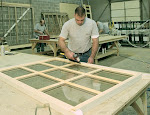Last week I gave my 17-year-old daughter the speech about how when something looks too good to be true, it usually is. A teenager’s life is certainly challenging and doesn’t need to be complicated by Internet scams, Lance Armstrong-type role models, and cyber-boyfriends who don’t really exist. This made me think about a building material that has proven to defy this principle.
I have been in the wood window business for 26 years and have been very dismayed at the poor quality of manufactured windows in the United States. As a result, my company is constantly searching for better finishes, exterior cladding methods, preservative treatments, and more durable wood species. It was in this quest that we ran across a wood called Accoya. The website said the wood is guaranteed to last 50 years unfinished above ground and is more durable than teak. Normally I would have just laughed and then placed another order for mahogany, but the fact that the product has been used in Europe for the past 75 years piqued my interest.
Accoya is radiata pine that is subjected to a proprietary non-toxic process that permanently changes the molecular structure of the wood. Accoya is based on acetylated wood technology which is a process that impregnates wood with acetic anhydride, which is similar to a very strong vinegar. This produces a wood that smells like the salad I had last weekend. The process involves placing the lumber into massive pressure vessels and forcing acetic anhydride under immense pressure into the very core of the wood. This process is then reversed and a vacuum removes 99.7% of the liquid from the wood, leaving the radiata pine permanently altered. The resulting product is a wood that absorbs water, but doesn’t swell up in the process so its dimensionally stable, impregnable to fungi, and not attractive to insects. Sounds too good to be true, doesn’t it?
The engineers at Re-View put the product through our own testing regimen to see if we might consider it for window fabrication. We took sample wood blocks of Accoya and tested the internal moisture content and measured the outside dimensions with a micrometer. We then submersed the wood blocks into a bucket of water for 30 days. When we removed the blocks and tested the moisture and dimensions, nothing had changed. That single test convinced our team that this wood had serious potential.
Our next step was to see how the wood reacted to all of the other products that come into contact with the wood. Of primary importance was how different finishes reacted to the acetylated wood. Sherwin Williams conducted a series of tests and determined that the best combination of exterior finishes was an oil-based primer with an acrylic latex intermediate and final finish. The wood was exposed to 1540 hours of testing in a humidity chamber and freeze/thaw cycles from -5F to 120F. The finishes passed with flying colors. One thing we did discover is that the wide grain pattern of the radiata pine is not very suitable for an interior stain application. Accoya has recently made improvements by introducing an acetylated alder option that stains much better than the radiata.
In addition to the testing of the finishes, our staff tested adhesives. We discovered that polyvinyl Acetate (PVA) based glue like the Titebond II and Titebond III, or the Gorilla Wood Glue products are not effective with Accoya. The best adhesive for joinery and glue ups of Accoya is a polyurethane-based glue. Gorilla Glue makes a good polyurethane adhesive so we had the company conduct adhesion tests using Gorilla Glue on a mortise and tenon joint. The polyurethane Gorilla Glue is a very effective bonding agent for the Accoya species.
Finally we tested different fasteners that are exposed to the Accoya. We found that only non-ferrous fasteners can be used with Accoya. The acetic anhydride used in making the wood will accelerate deterioration of typical steel or galvanized nails and screws. Since it is a good practice to only use stainless steel fasteners for exterior applications, this isn’t a problem.
Accoya is very nearly too good to be true. Our research, however, shows that this revolutionary wood provides the following:
1. Outstanding Durability – Accoya has a Class 1 rated durability that surpasses teak and has a 50 year warranty for above ground applications and 25 years below ground.
2. Dimensionally Stable – Since Accoya doesn’t absorb moisture, shrinking, swelling, and warping is dramatically reduced which makes it more compatible for fabrication and better performing in the field.
3. Insect Barrier – Since Accoya is indigestible to a wide range of insects including termites, it doesn’t need additional treatments that have a limited performance life.
4. Sustainable – Accoya comes from managed forests and is certified by FSC, PERC and other regional certification bodies.
5. Excellent Machinability – Accoya is made from either radiata pine or alder, both of which are great woods for machining.
Re-View has used Accoya on many national landmark projects. It is our intent to manufacture windows that will last 50-100 years, and we think Accoya is an excellent material to meet that goal. You can see some of the projects Re-View has done by accessing the following link: Re-View Facebook
The Dutch town of Sneek wanted the town's entry
bridge to be a symbol of its maritime history. Accoya
was selected because of its incredible durability.
The "Moses Bridge" is crafted with Accoya because
it can withstand constant exposure to water.








Hi, nice post. Well what can I say is that these is an interesting and very informative topic. Thanks for sharing your ideas, its not just entertaining but also gives your reader knowledge. Good blogs style too, Cheers!
ReplyDeleteHistoric Wood Window MA